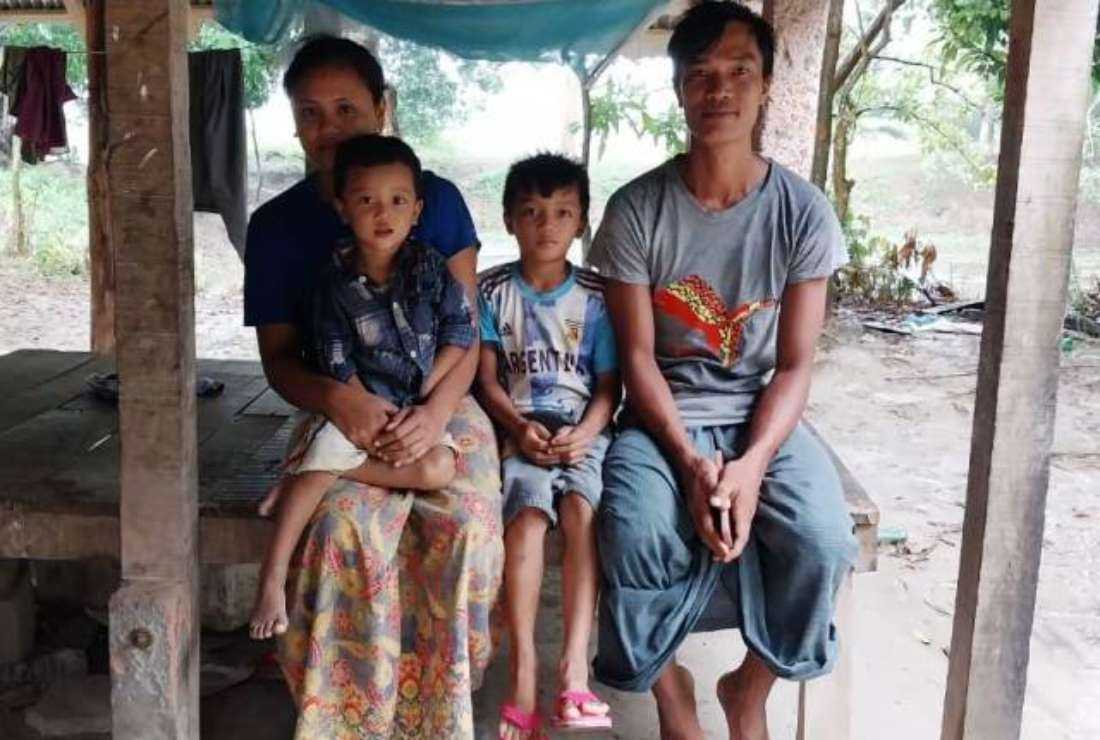Muslim majority has replaced minority ethnic group in their villages in coastal districts of Patuakhali and Barguna

Chu Shwe, his wife Cho Nai and their two sons beside the pond in the Rakhain village of Nayapara in Mohipur, a rural area in Bangladesh’s southern coastal district of Patuakhali. (Photo supplied)
Chu Shwe has ignored the lure of cash and repeated threats to his life to stay put in his ancestral Rakhine village of Nayapara in Mohipur, a rural area in Bangladesh’s southern coastal district of Patuakhali.
The traditional wooden house, where he lives with his wife and two sons, is located next to a beautiful pond, deep and decorated with naturally grown lotus plants.
It was once the only water source for the families of the Rakhine people, a minority ethnic group who follow Buddhism in the Muslim-majority South Asian nation.
But Bengali land grabbers now want the pond. They want to fill it in and exploit it for profit. The land grabbers threaten to get the pond anyway, with or without Chu Shwe’s consent, claiming that they are backed by the authorities and the state.
“I feel like I have to protect this pond. I am one of the last few Rakhines living in my village,” said Chu Shwe, who says it was his grandparents who donated the pond to the village.
Nayapara was home to 25 to 30 families until 20 years back, he recalls.
But now only six families remain in the village — a grim reminder of the decline in the Rakhine population along Bangladesh’s southern coast.
Their ancestors are said to have first arrived on the coast in sailboats from Myanmar in the last quarter of the 18th century.
Initially, only about 1,000 Rakhines came, much the same way Rohingyas would arrive in Bangladesh’s Cox’s Bazar some 250 years later, in sailboats fleeing violence and atrocities in Myanmar.
Dangerous place for Rakhines
In fact, Luma Rakhine, a local Rakhine leader and activist campaigning against the encroachment, calls his people the “Rohingyas of Bangladesh,” apparently referring to their present situation where they are being evicted from their ancestral lands and forced to move to Myanmar.
But unlike present-day Rohingyas, the Rakhine people arrived long before Bangladesh came into existence at a desolate spot along the coast, covered with dense forests and often struck by cyclones.
Still, they managed to flourish by cultivating the dense coastal forests.
The Rakhine population reached some 50,000 by the beginning of the 20th century. But, then, their numbers started to drop.
Tahan, an 86-year-old Rakhine author, and researcher who goes by a single name, says the Rakhines began leaving Bangladesh due to land encroachment and other rights violations.
About 15,000 Rakhine left between 1900 and 1948. Then, the next four decades witnessed the biggest departure of Rakhine people with 31,500 leaving between 1948 and 1991. Most left for Rakhine state in present-day Myanmar, Rakhine researchers say.
Tahan’s account of the Rakhine exodus coincides with a surge in religious violence in this part of the world after the British partitioned the Indian sub-continent in 1947, resulting in the creation of India and Pakistan. Present-day Bangladesh was part of Pakistan until 1971 when it became an independent nation.
In the coastal districts of Patuakhali and Barguna, Tahan estimates that the number of Rakhine villages dropped to 47 in 2004 from 237 in 1900.
A survey published in 2015 by Caritas Bangladesh, a Catholic charitable organization, revealed that only 2,535 Rakhines, living in 661 households, remained in Patuakhali and Barguna districts.
In 2021, Caritas said the number of Rakhine villages further declined to 46 with a 250-year-old Rakhine village in the Patuakhali district disappearing altogether in November 2021.
Rakhine rights activist Myentthein Promila says that “unfortunately” Bangladesh, which was born as a secular nation, “did not feel like home to the Rakhines.”
“In fact, it became even more dangerous for Rakhines to live in Bangladesh,” Promila said citing the experiences of the Rakhine elders.
Rakhines fast disappearing
In its latest population census, released in 2022, the Bangladesh Bureau of Statistics revealed that there were 11,195 Rakhines living in Bangladesh, including in the southeastern coastal district of Cox’s Bazar under Chittagong Division, besides Barguna and Patuakhali.
The Rakhines, however, suspect the government census reports have misrepresented their numbers over the years.
The 2022 census reveals that Bangladesh’s overall ethnic minority population dropped to just 1 percent from 1.10 percent in 2011 while the Muslim majority population increased by 0.65 percent.
Bangladesh has some 1 million Buddhists and some 65 percent of them belong to ethnic groups such as Rakhine, Chakma, Marma, Tanchangya and Barua and live in Chittagong Hill Tracts. The rest are ethnic Bengali people, mostly living in Chittagong and Dakha.
Buddhists comprise the third largest religious group after Muslims and Hindus, though they barely form 0.61 percent of the nation’s over 165 million people according to the 2022 census.
The Buddhist population registered negative growth. In the 2011 census, their share was 0.62 percent in a population of 158 million.
The latest departures by the Rakhine people are mainly triggered by land encroachments, which are initiated by the filing of land dispute cases based on fake documents, allege Rakhine leaders and researchers.
A Caritas survey released in 2019 revealed that 473 out of 661 Rakhine families in Barguna and Patuakhali were facing legal cases, all of them land related.
“The way the population of Rakhines is declining can be defined as ‘un-peopling,’” says Robaet Ferdous, a minority rights activist, who also teaches mass communication and journalism at Dhaka University.
“The day is not too far when there will be zero Rakhine around,” he said.
Muslims replace the Rakhine people
Rakhine Buddhist leaders say land grabbing by government agencies is a major reason for their people to disappear from Bangladesh.
One example they project is the case of the 250-year-old Rakhine temple, the Srimangal Buddhist Temple in Kuakata, Patuakhali.
Some 73 percent of the temple land is currently under use by the Water Development Board (WDB) and the local deputy commissioner’s office for the purpose of building guest houses and embankments, they say.
The WDB proposes to lease out parts of the temple land to the local journalists to build a press club.
“The temple is the last tie Rakhines have to this land,’ said Indhro Bongsho Bhikkhu, the chief priest of the Srimangal Buddhist Temple.
Rakhine leaders say some 50 percent of temples across the Rakhine villages in Patuakhali and Barguna have been lost to encroachments in the past three decades, besides the loss of 70 percent of their lands including burial grounds.
Members of the Muslim majority have replaced the Rakhines in their villages, leaving no traces of the ethnic minority people in the villages. The Rakhine temples and burial grounds have been replaced with infrastructure or even garbage dumps, allege Rakhine leaders.
“This is clearly Islamization and Bengalization which goes against Bangladesh’s founding spirit,” said Nazmul Haque Prodhan, a senior politician and former parliamentarian, who recently visited Rakhine villages in Patuakhali.










